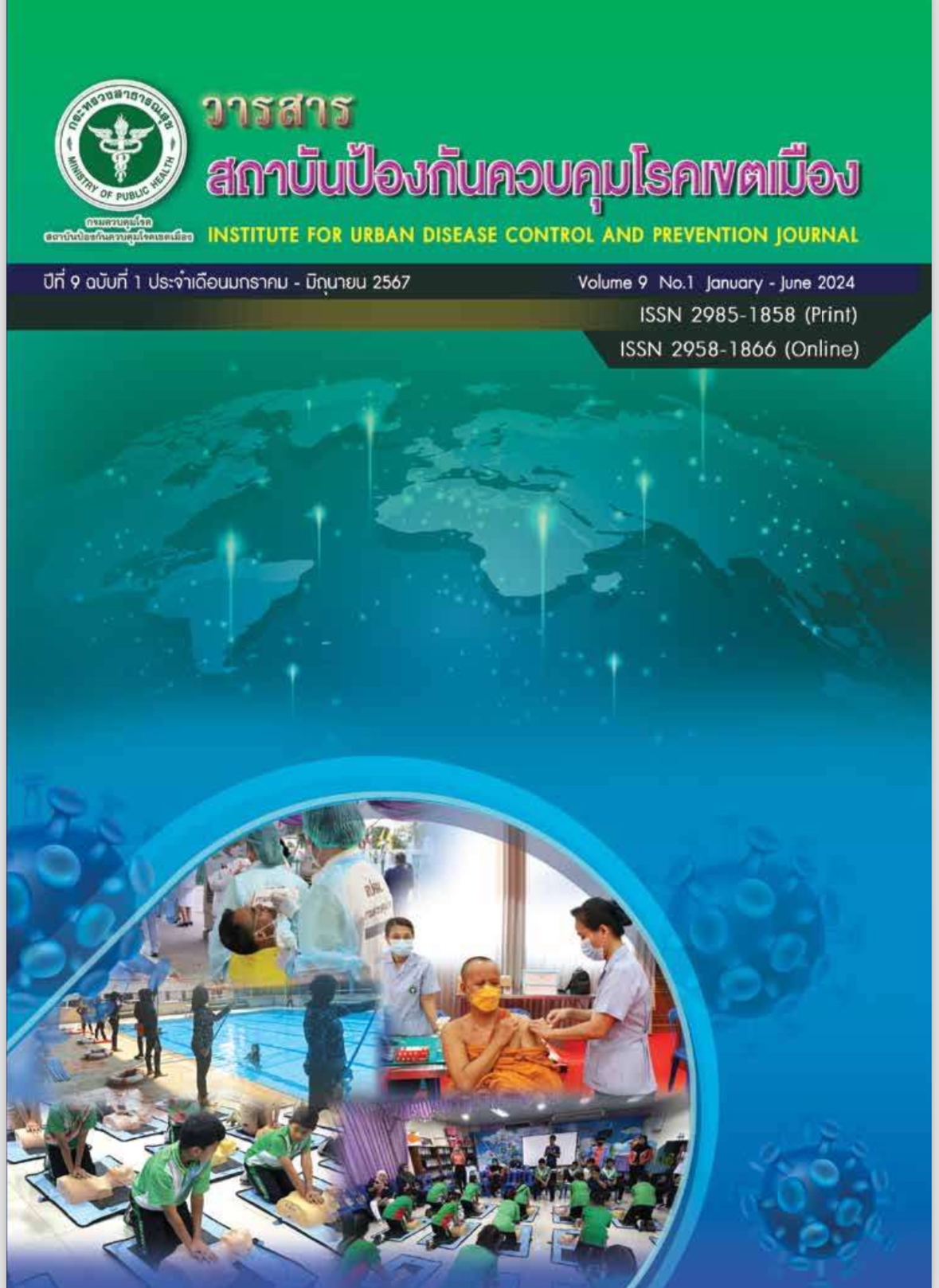ลักษณะบุคลิกภาพที่มีผลต่อพฤติกรรมการขับขี่และอุบัติเหตุจราจร
Main Article Content
บทคัดย่อ
อุบัติเหตุจราจรก่อให้เกิดความสูญเสียทั้งชีวิตและทรัพย์สินเป็นจำนวนมาก ซึ่งพฤติกรรมและบุคลิกภาพบางชนิดเป็นปัจจัยหนึ่งที่สำคัญต่อการนำไปสู่อุบัติเหตุจราจร ซึ่งที่ผ่านมามีงานวิจัยที่ศึกษาและสรุปถึงความสัมพันธ์ของบุคลิกภาพกับความเสี่ยงต่อการเกิดอุบัติเหตุจราจรไว้อย่างหลากหลาย งานวิชาการนี้เป็นการศึกษาค้นคว้า และทบทวนวรรณกรรม โดยมีวัตถุประสงค์ ในการค้นคว้าบุคลิกภาพและการแสดงออกที่สัมพันธ์กับการเกิดอุบัติเหตุจราจรมากที่สุด จากการทบทวนวรรณกรรมต่าง ๆ และการใช้เครื่องมือในทางวิทยาศาสตร์เป็นตัวชี้วัดแนวโน้มของบุคลิกภาพที่ทบทวนมาแล้วว่ามีความสัมพันธ์ต่อการเกิดอุบัติเหตุจราจร โดยวิธีการศึกษาจะใช้การทบทวนวรรณกรรมแบบปริทัศน์พรรณนา จากค่าสถิติ งานวิจัย บทความ และผลงานวิชาการที่เกี่ยวข้อง ผลการศึกษาพบว่ากลุ่มบุคลิกภาพต่อต้านสังคมมีแนวโน้มการเกิดอุบัติเหตุจราจรมากกว่าคนทั่วไป และบุคลิกภาพแบบแสวงหาความเสี่ยงซึ่งเป็นหนึ่งในกลุ่มบุคลิกต่อต้านสังคมนั้น จะมีความสัมพันธ์จำเพาะกับการเกิดอุบัติเหตุจราจรมากที่สุด ซึ่งกล่าวโดยสรุปได้ว่าการมีแนวทางการประเมินผู้ที่มีลักษณะกลุ่มบุคลิกภาพแบบต่อต้านสังคม และบุคลิกภาพแบบแสวงหาความเสี่ยง ก่อนการขับขี่ จะเป็นการคัดกรองผู้ที่มีความเสี่ยงในการเกิดอุบัติเหตุจราจร และนำไปสู่การให้คำแนะนำด้านการเฝ้าระวังความเสี่ยงในการขับขี่แก่ประชาชนที่มีลักษณะบุคลิกเสี่ยงได้อย่างเหมาะสมต่อไป
Article Details

อนุญาตภายใต้เงื่อนไข Creative Commons Attribution-NonCommercial-NoDerivatives 4.0 International License.
บทความที่พิมพ์ในวารสารสถาบันป้องกันควบคุมโรคเขตเมือง ถือว่าเป็นผลงานวิชาการ งานวิจัยและวิเคราะห์ ตลอดจนเป็นความเห็นส่วนตัวของผู้เขียนเอง ไม่ใช่ความเห็นของสถาบันป้องกันควบคุมโรคเขตเมือง หรือคณะบรรณาธิการแต่ประการใด ผู้เขียนจำต้องรับผิดชอบต่อบทความของตน
เอกสารอ้างอิง
Suphanchaimat R, Sornsrivichai V, Limwattananon S, Thammawijaya P. Economic development and road traffic injuries and fatalities in Thailand: An application of spatial panel data analysis, 2012–2016. BMC public health. 2019;19:1-15.
ธนะพงศ์ จินวงษ์. อุบัติเหตุทางถนน “ภัยเงียบ” ที่ยังอันตรายและท้าทายการจัดการ. วารสารการแพทย์ฉุกเฉินแห่งประเทศไทย. 2564;1(1):71-6.
สถิติกรมทางหลวง [อินเตอร์เน็ต]. กรุงเทพฯ: สำนักอำนวยความปลอดภัย กรมทางหลวง. 2566 - [เข้าถึงเมื่อ 9 พ.ย. 2566]. เข้าถึงได้จาก: https://bhs.doh.go.th/home
Wang Y, Qu W, Ge Y, Sun X, Zhang K. Effect of personality traits on driving style: Psychometric adaption of the multidimensional driving style inventory in a Chinese sample. PLoS One. 2018;13(9):1-17.
Aluja A, Balada F, García O, García LF. Psychological predictors of risky driving: the role of age, gender, personality traits (Zuckerman's and Gray's models), and decision-making styles. Front Psychol. 2023;14:1-14.
Lucidi F, Girelli L, Chirico A, Alivernini F, Cozzolino M, Violani C, et al. Personality Traits and Attitudes Toward Traffic Safety Predict Risky Behavior Across Young, Adult, and Older Drivers. Front Psychol. 2019;10(536):1-11.
Roberti JW. A review of behavioral and biological correlates of sensation seeking. Journal of research in personality. 2004;38(3):256-79.
Rahmani S, Lavasani MG. Gender differences in five factor model of personality and sensation seeking. Procedia-Social and Behavioral Sciences. 2012;46:2906-11.
Gellman MD, Turner JR, editors. Encyclopedia of Behavioral Medicine. New York: Springer; 2013. p. 993-994.
Rosli NS, Yunus JM, Hanan SA. Influence of Agreeableness Personality Trait on Driving Behaviour among Motorists in Malaysia. RA Journal of Applied Research. 2017;3(12):1324-30.
Bortolato M, Shih JC. Behavioral outcomes of monoamine oxidase deficiency: preclinical and clinical evidence. Int Rev Neurobiol. 2011;100:13-42.
Shih JC, Thompson RF. Monoamine oxidase in neuropsychiatry and behavior. Am J Hum Genet. 1999 ;65(3):593-8.
Kolla NJ, Vinette SA. Monoamine Oxidase A in Antisocial Personality Disorder and Borderline Personality Disorder. Curr Behav Neurosci Rep. 2017;4(1):41-48.
Malakoutikhah M, Jahangiri M, Alimohammadlou M, Faghihi SA, Kamalinia M. The Factors Affecting Unsafe Behaviors of Iranian Workers: A Qualitative Study Based on Grounded Theory. Saf Health Work. 2021;12(3):339-345.
Nasaescu E, Zych I, Ortega-Ruiz R, Farrington DP, Llorent VJ. Longitudinal patterns of antisocial behaviors in early adolescence: A latent class and latent transition analysis. The European Journal of Psychology Applied to Legal Context. 2020;12(2):85-92.
Leppink EW, Chamberlain SR, Redden SA, Grant JE. Problematic sexual behavior in young adults: Associations across clinical, behavioral, and neurocognitive variables. Psychiatry Res. 2016;246:230-5.
Shackelford TK, Weekes-Shackelford VA, editors. Encyclopedia of Evolutionary Psychological Science. Cham: Spinger; 2021. p. 3858-65.
Patra P, Prakash J, Patra B, Khanna P. Intimate partner violence: Wounds are deeper. Indian J Psychiatry. 2018 Oct-Dec;60(4):494-8.
Bakhshani NM. Impulsivity: a predisposition toward risky behaviors. Int J High Risk Behav Addict. 2014;3(2):1-3.
Friedman HS. Encyclopedia of mental health. 2nd ed. Oxford: Academic Press; 2015.
Dade P. Encyclopedia of child behavior and development. Reference Reviews; Harlow. 2011;25(6):10-11.
Zou Z, Wang H, d'Oleire Uquillas F, Wang X, Ding J, Chen H. Definition of Substance and Non-substance Addiction. Adv Exp Med Biol. 2017;1010:21-41.
Himawan A, Suryanto, Pratitis NT. The Psychological Dynamics Underlying of Criminal Theft Accompanied by Violence. JournEEL. 2021;3(1):55-64.
Abdoli N, Farnia V, Salemi S, Tatari F, Shakeri J, Basanj B, AhmadiJuibari T, Bahrampouri S. Predictors of substance abuse among risky drivers: The role of personality characteristics and mental health. J Educ Health Promot. 2018;7:163.1-6.
Urieta P, Aluja A, Garcia LF, Balada F, Lacomba E. Decision-Making and the Alternative Five Factor Personality Model: Exploring the Role of Personality Traits, Age, Sex and Social Position. Front Psychol. 2021;12:1-12.
Aluja A, Lucas I, Blanch A, Lopez OG, García LF. The Zuckerman-Kuhlman-Aluja personality questionnaire shortened form (ZKA-PQ/SF). Personality and Individual Differences 2018;134:174-81.
Berisha G, Pula JS, Krasniqi B. Convergent validity of two decision making style measures. Journal of Dynamic Decision Making. 2018;4(1):1-8.
Zuckerman M. Zuckerman-Kuhlman Personality Questionnaire (ZKPQ): An Operational Definition of the Alternative Five Factorial Model of Personality. In: Boyle GJ, Matthews G, Saklofske DH, editors. The SAGE Handbook of Personality Theory and Assessment: Volume 2 - Personality Measurement and Testing. London: SAGE Publications Ltd; 2008. p. 219-222.
วรวัชร์ ตั้งจิตรเจริญ, บุรชัย อัศวทวีบุญ, ชลาลัย แต้ศิลปะสาธิต, ดำรงค์ อดุลยฤทธิกุล, พนิดา ซิมาภรณ์, สาวิตรี แฮมมอนด์, และคณะ. การพัฒนาแบบทดสอบ MMPI-2-RF ฉบับภาษาไทย: การแปลและการทดสอบแบบวัดซ้ำกับผู้ที่ชำนาญสองภาษา. วารสารสมาคมจิตแพทย์แห่งประเทศไทย. 2560;62(4):349-58.
Zuckerman M, Aluja A. Measures of sensation seeking. In: Boyle GJ, Saklofske DH, Matthews G, editors. Measures of personality and social psychological constructs. London: Academic Press; 2015. p. 352-80.
Shinohara K, Renge K. Perception and cognition of drivers. In: International association of traffic and safety sciences, editor. Traffic and Safety Sciences. Tokyo: The Japan Times, Ltd.; 2015. p. 80-1.
Kaul R, Jipp M. Influence of cognitive processes on driver decision-making in dilemma zone. Transportation research interdisciplinary perspectives. 2023;19:1-9.


